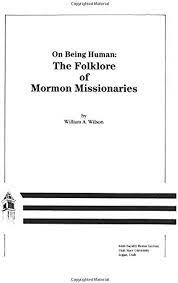Articles/Essays – Volume 16, No. 2
A Stab at Self-Consciousness | William A. Wilson, On Being Human: The Folklore of Mormon Missionaries
Criticizing the publication of William A. Wilson’s 18 November 1981 Honor Lecture in the Humanities would be equivalent to rudely refusing to applaud a virtuoso folklore performance. Although claiming to play the role of a critic, Wilson uses missionary stories to punctuate his points in such a way that the lecture comes close to his own definition of folklore—”an artful rendering of significant human experience” (p. 6). The sharing of these stories or simi lar ones is an integral part of Mormon culture, but the structuring of Mormon folk lore into a pattern from which to draw conclusions about Mormon culture is a self conscious act which is usually avoided like a plague of critics. But it is just this somewhat daring stab at self-consciousness that makes this lecture worthy of comment.
Wilson chose a subject inherently intriguing to Mormons. The missionary experience is a vital ingredient of the gospel, and yet why missionaries, young and unschooled for the most part, achieve the success they do remains an enigma to the world at large and often to Mormons as well. Is it their very inexperience which makes missionaries an unthreatening subject for a study of universality such as this? No other Mormon subgroup could so easily and freely be discussed.
Anyone who has taken seriously the requirement “every member a missionary” has some sense of the frustrations present in the life of the full-time missionary. Wil son’s analysis of their folklore reveals how missionaries not only deal with these frustrations but also enrich their lives at the same time. With the stated purpose of showing how folklore can “increase our understanding of the human condition” (p. 1), Wilson outlines four ways missionaries use folklore: “Through the performance of this lore they develop a strong esprit de corps; they relieve the pressures imposed by the rule-bound nature of the system; they channel behavior down acceptable paths; and, most important, they develop a picture of a world that can be overcome” (p. 2). He illustrates each of these uses with stories collected from returned missionaries at Utah State University and Brigham Young University. Because the problems addressed by this folklore are human problems not unique to Mormon missionaries, understanding folklore, Wilson claims, can help us understand human beings.
That global understanding would only be possible, however, with a more extensive analysis than the one offered, for this brief lecture tantalizes but does not satisfy. There is some relief that the Mormon oral tradition is being discussed in a scholarly fashion (even limited as it is here to missionaries), but the analysis is reductionistic. The missionary experience is revealed only in part by what Wilson discusses. Although he briefly outlines the broad range of experience which folklorists study, he does not include missionary practices which explore that breadth of possibilities. He gives no information about the choice of informants or methods of collection. But a lecture is not a book and something in this case is better than nothing. Besides, discussing the oral tradition by oral means is not only clever but appropriate.
Although nicely presented and certainly more carefully edited, this is the same lecture which was published in Sunstone (Jan.-Feb. 1982): 32-40. I would not want another reader to assume as I did that this must be the hoped-for book following the provocative article. Wilson and John B. Harris are planning a book but the project is still in the organization stage. Certainly, collecting the stories is the first priority of the folklorist, and Wilson and Harris fulfill a need if they go no further.
I shared Wilson’s lecture with my son Derek who had been home less than a week from the Italy Catania Mission. It was delightful watching him read and chuckle and then stop to tell me of similar experiences and stories. Derek told me of two missionaries who had been convinced by their senior companions that their length of service now entitled them to a P-week (a week off). They dutifully sent elaborate plans of their proposed vacation to Switzer land to the mission president for approval. This story combines the first three uses of folklore as “greenies” are initiated, vacations are contemplated, but mission rules are reinforced. Derek expressed relief that he had not been gullible enough to believe some stories Wilson recorded, but with cha grin admitted that he had so thoroughly believed others. He said he was glad that he now knew “the truth.” But Derek believed, as do all good missionaries, because he needed and wanted to believe and because the performance of folklore creates its own truth.
Perhaps rightly, Wilson does not deal directly with this issue of truth. There seems to be an underlying assumption that as folklore these stories are shaped for a purpose and have no necessary basis in fact. But just as myth need not be narrowly de fined as an untrue story, so folklore can embody symbolic truth, transcending insistence that a “true” story must happen just the way the teller specifies. What is often most interesting about human beings is how they interpret their experiences. That undoubtedly is the basis for the charm and much of the power inherent in the testimony meeting. Folklore can reveal these rich interpretations and increase our understanding of the human condition. Reading On Being Human will do for others what it did for Derek: the act of reading and pondering will delight, will recall similar incidents, and will cause valuable self-consciousness about the missionary experience which, in turn, will help explicate the experience of being human.
On Being Human: The Folklore of Mormon Missionaries by William A. Wil son (Logan, Utah: Utah State University Press, 1981), 24 pp., $1.60 (Sixty-fourth Annual Faculty Honor Lecture in the Humanities).


 Back to full Issue
Back to full Issue

